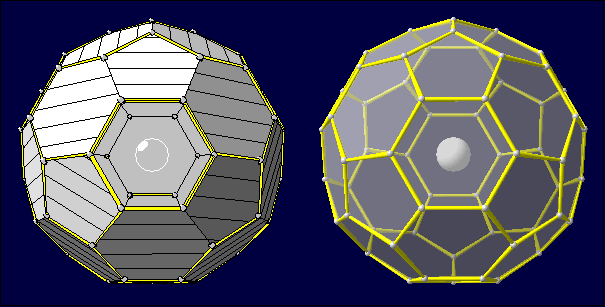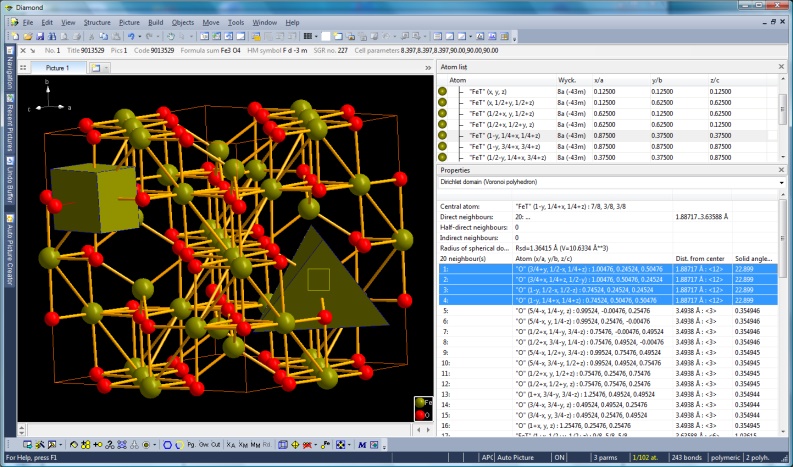Diamond Features: Polyhedron functions
Go to Diamond Features Overview
Previous: Functionality for molecules and polymers
Next: Calculate and measure distances, angles, planes, lines and more
Generation of coordination polyhedra
There are in principle two different modes to create polyhedra:
a) The semi-automatic creation, where Diamond searches for the coordinating atoms within a given enclosure sphere and creates these atoms, if necessary.
These central atoms can be all atoms of the structure picture belonging to selected atom types or selected atom sites
or around atoms that are individually selected in the structure picture.
b) The manual creation, where you select the atoms that will become corners of the polyhedron.
In that case, Diamond searches for a suitable central atom or creates a dummy atom, when there is no suitable atom in the parameter list.

Sample from the Diamond tutorial where you build a polyhedron model for a Keggoin structure, here two Keggin ion building blocks present in the unit cell
Several design properties for polyhedra
You can define the color of the polyhedron faces and the color, style and thickness of the polyhedron edges.
The polyhedron faces can have transparent or hatched surfaces.

Define polyhedron's constituent atoms from atom site environment
Atom site environments can be used to define a coordination polyhedron (besides fixed-sized
and generic spheres, i.e. basing upon connectivity bonding spheres)
in the "Add polyhedra" function. Additionally it is possible to take over the
coordination sphere (the bonded neighbouring atoms) of a (central) atom as is, i.e.
without filling the coordination sphere.
Enhanced construction from selected atoms or bonds
Although Diamond offers a lot of settings to create coordination polyhedra
from complicated environments and in spite of the epsilon angle that decides, if
two or more triangles form a higher polygon (polyhedron face), it may become a difficult
task to achieve your desired polyhedron. Besides the method to construct a polyhedron
by collecting the constituent atoms from the selected atoms, you can also construct
it from bonds (between the constituent atoms, i.e. the bonds will be converted to
edges).
Combination or splitting of faces by clicking
Triangular polyhedron faces where you expect to have higher polygons can be combined
simply by clicking the polygon's atoms, or - vice versa - a rectangle or higher
polygon can be split into lower polygons and triangles, if necessary.
Copy and paste of polyhedra between atoms of same site
A more or less manually created coordination polyhedron (using the above mentioned
methods) can be assigned to other atoms in the structure picture belonging to the
same site. (That is: a polyhedron prototype is assigned to an atom site each.) In general, you can do a Copy and Paste of polyhedra between atoms of
same site.
Creation of Voronoi polyhedra
Voronoi polyhedra can be created for selected atoms or atoms of selected sites
basing upon their Dirichlet domains. (Example: magnetite from COD:9013529).
There are several options for the style of the polyhedron as well
as if and how
to show and connect the neighbouring atoms. Infos about a selected Voronoi polyhedron
(neighbouring atoms, distances, bond strengths, solid angles, etc.) are available
from the Properties view.

Screenshot (from Diamond version 4) with Voronoi polyhedra and Dirichlet domain of tetrahedrally coordinated iron in magnetite (COD:9013529) in Properties view
(Full size image: 470 KB)
Go to Diamond Features Overview
Previous: Functionality for molecules and polymers
Next: Calculate and measure distances, angles, planes, lines and more
|

